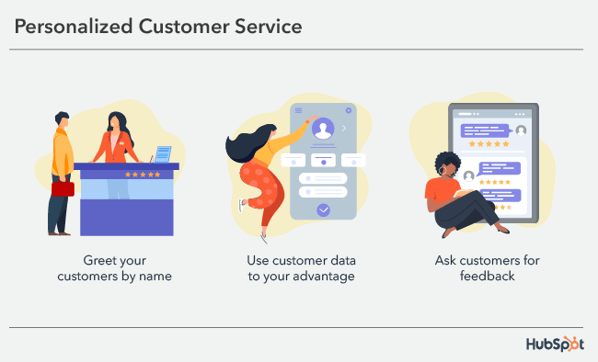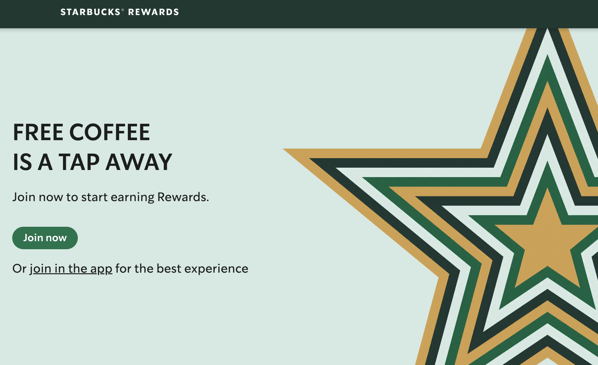Goodbye one-size-fits-all customer service, and hello personalized customer service.

Did you know that 54% of consumers say they expect all of their experiences to be personalized when they interact with businesses? Plus, over 90% of customers are likely to spend more money with companies that can offer the personalization they're looking for.
In this article, we'll discuss what personalized customer service means along with 10 easy ways to make things feel personal (in a good way) for your customers. Let's get started.
Personalized Customer Service
What is personalized customer service? The short answer is: It's all about getting to know your customers and using that information to tailor the customer experience. No two customers are alike. Personalized customer service allows you to treat customers as individuals based on the attributes, behaviors, and preferences that are unique to them.
Now that you know what personalized customer service is, let's discuss why it's an important strategy for your business.
Why is personalized customer service important?
Personalizing the customer journey allows you to build deeper relationships with your customer base. The more you learn about your customers, the easier it is to understand how to make (and keep) them engaged with your company. Personalization can also show your customers that you value them as individuals, and that you're willing to go the extra mile to meet their specific needs.
All of these factors can lead to increased customer satisfaction and loyalty, as well as improved sales and profitability. In fact, your online conversion rate alone can improve by roughly 8% when you include personalized consumer experiences.
The sum of it is: If you want to keep your customers happy and retain their business, you'll need to truly understand what their needs are and tailor your services to each individual customer accordingly.
So, it's clear that personalization is an important part of customer service. But the how is just as important as the why when it comes to implementation. We'll discuss that next.
How to Provide Personalized Customer Service
As shown in the image below, you can personalize the customer experience in a number of ways. This includes collecting customer data and using that to provide a more individualized experience or offering custom solutions to meet your customers' specific needs.

Below, we've included a full list of the best 10 ways to deliver personalized customer service at your company.
10 Ways to Deliver Personalized Customer Service
- Learn (and use) your customers' names.
- Be friendly and human.
- Collect and leverage customer data.
- Offer custom and unique solutions.
- Get to know your customers on a personal level.
- Provide a VIP experience for your best customers.
- Use technology to your advantage.
- Train and empower your support reps.
- Create a seamless omni-channel experience.
- Get feedback from your customers.
1. Learn (and use) your customers' names.
Chances are high that you already have the names of your existing customers, so don't be afraid to use them. And for new customers? Ask and capture them. This way, customer service reps can easily greet their customers by name over the phone, in an email, or via live chat.
Why this works: It's simple yet effective. Knowing someone's name is step one when it comes to building relationships. Plus, it feels a lot better to be referred to by your name than a generic 'customer12345' placeholder.
2. Be friendly and human.
In addition to knowing your customers' names, treat your conversations like you're talking to a friend or family member. Don't skip the niceties or miss an opportunity to turn even the toughest of conversations into a positive interaction.
Why this works: When you humanize the conversation, it's a lot easier to make customers feel like you're focused on them and their problems as an individual. And kindness and positivity both go a long way when it comes to customer delight.
3. Collect and leverage customer data.
You're already collecting more customer data than you probably realize, so use it to your advantage. Learn about your customers' browsing habits and purchase behaviors so you can tailor your communications to their specific interests.
Why this works: It takes the guesswork out of your customer interactions. You can use this data to make informed product recommendations or send targeted communications based on your customers' preferences.
4. Offer custom and unique solutions.
Once you learn more about your customers, it becomes easier to customize your products and services based on their needs. This could involve providing custom quotes to meet customer specifications or designing unique products to align with a specific customer's request.
Why this works: This goes back to the fact that one-size-fits-all customer service is going out of style. Not all customers are the same, and offering custom products and services shows them that you understand how to satisfy their needs as an individual.
5. Get to know your customers on a personal level.
As a business, it's important to build relationships with your customers. Take opportunities to learn more about your customers — beyond just their order history. This includes their interests and hobbies, as well as their likes and dislikes.
Why this works: The more you know about your customers, the better your relationship will be. And customers who build a strong relationship with your brand are less likely to churn.
6. Provide a VIP experience for your best customers.
Show your best customers that you appreciate them for being, well, the best. You could offer special discounts or freebies to your repeat buyers. Or show your longest-standing customers that you care about them by giving them exclusive access to new products or services.
Why this works: Perks are a great way to keep your customers happy and engaged with your company. And by recognizing that an individual customer has bought from you multiple times or been with your brand for a lifetime shows them that you appreciate their business.
7. Use technology to your advantage.
There are a number of ways you can use technology to provide a more personalized customer service experience. For example, achatbot is a great automated tool that you can use to answer common customer questions or inquiries.
Why this works: Speed is one of the most important principles of customer service. Automated technology like chatbots can help your support team address a larger volume of individual customer requests more quickly and effectively.
8. Train and empower your support reps.
Documentation like canned responses can be helpful guidance for customer interactions. But it's also a good idea to give your support reps the tools to go off-script, and encourage them to make each customer conversation their own.
Why this works: In addition to adding that human element we talked about earlier, this gives reps the flexibility to tailor the conversation to the individual customer. Plus, the conversation feels a lot more real when agents have the power to control it.
9. Create a seamless omni-channel experience.
Saying goodbye to one-size-fits-all customer service means the same for communication channels too. The reality is that customers want to be able to access your products and services on multiple platforms. So make it easy to do so, and keep the customer experience consistent.
Why this works: When a customer can access a single profile or customer hub regardless of the channel they're using, that means they don't have to repeat themselves or keep restarting the customer service process for the same issue. Customer frustration avoided.
10. Get feedback from your customers.
The best way to show customers that you value them as individuals is by asking for their feedback on how well your company is meeting their needs — and how you can do better. Surveys are the perfect tool to collect this level of customer insights and data.
Why this works: When you ask for feedback, this gives you the opportunity to take a step back and actually listen to what your customers are saying. But implementation of this feedback is the key to creating the ultimate personalized customer experience.
Now that we've covered the what, why, and how of personalized customer service, let's take a look at a few examples of businesses that are doing it right.
Personalized Customer Service Examples
Amazon, Zappos, and Starbucks are three examples of brands that do a good job of personalizing their customer service strategy.
We'll take a look at each in more detail below.
Amazon

Amazon is a prime (no pun intended) example of a company that provides personalized customer service. They use data collected about their customers to provide a more customized experience.
For example, Amazon uses purchase history data to make product recommendations and send targeted emails with special offers based on customer interests.
They also offer custom solutions to meet customers' specific needs, such as their Amazon Prime (OK, pun intended) service which provides free shipping and exclusive deals for members.
Zappos

Zappos is another company that excels at personalized customer service. They take the time to get to know their customers on a personal level and build relationships with them.
How do they do it? They make an effort to learn about their customers' interests and hobbies, as well as their likes and dislikes. And they tailor the communications for each customer based on the information they capture.
Zappos also provides a VIP experience for their best customers by giving them exclusive access to new products or services and offering special discounts.
Starbucks

Starbucks is also doing it right in terms of personalized customer service. They use technology to their advantage by using chatbots to answer common customer questions and AI to provide personalized food and beverage recommendations.
Starbucks is another company that tailors to their best customers through the Starbucks Rewards program, where customers can rack up stars for freebies and other tasty benefits.
Get Personal With Your Customers
Personalized customer service is a key element of success for any business. By taking the time to get to know your customers and offer custom solutions to meet their needs, you can create a loyal customer base that will keep coming back for more.


![10 Customer Onboarding Challenges You Might Face This Year [+Expert Tips]](https://blog.hubspot.com/hubfs/ai%20customer%20service%20predictions%20%282%29.webp)

![Advocacy Marketing: How to Do It Well in 2023 [Strategies + Examples]](https://blog.hubspot.com/hubfs/customer-advocacy.jpg)



![What To Do if Someone Threatens to Sue You [+Customer Service Lawsuit Tips]](https://blog.hubspot.com/hubfs/196_Customer-Service-Lawsuit-Tips.png)


